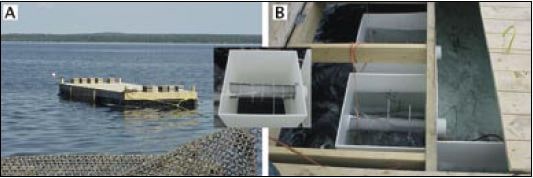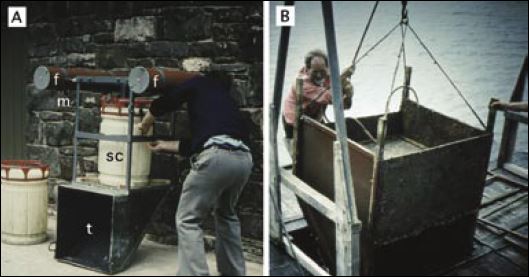6.6.2 Barge-type nurseries
Water flow in barge-type nurseries is generated by low-head (axial flow), propeller pumps, or electrically driven paddle wheels mounted in channels which receive the discharge from the upwelling containers (Figures 103 and 106). The pumps or paddle wheels force water out of the channel(s) back to the surrounding water. This causes a head difference between the level of the surrounding seawater and the lower water level in the discharge channel, with the result that water flows through the mesh bases of the upwelling containers from the outside. The water passes through the bed of contained spat and is discharged into the channel from which it is driven back to the sea or pond.
Regardless of the technology used, careful management must be exercised to match the total biomass of seed held in the unit with the continuity, quantity, and quality of available food. This is dependent on whether the barge is moored within a pond system (Figure 106A–C) or it is floating in an unmanaged saltwater lagoon or in an estuary (Figure 106E–F). The operator can choose between producing large numbers of small seed grown to a moderate size or a smaller number of seed grown to a larger size. Assuming the case of a barge moored in a productive estuary, a flow of between 10 and 20 l per minute per kg of spat should carry a sufficient supply of food to the animals. Each spat holding container (1 m2 base area), of which there may be up to 32 in a unit, will hold up to 120 kg of seed at the maximum biomass loading, requiring a flow per container of >1 200 l per minute. The total flow per 32-container unit will therefore be in excess of 38 400 l per minute (38.4 m3 per minute). A paddle wheel is more energy efficient in inducing a flow of this magnitude than is an axial flow, propeller pump. Driving a paddle wheel with an electric motor connected via a gearbox provides scope to vary the total flow according to the size of spat and the total biomass held. Lower flow rates per unit biomass than those quoted above may be appropriate in a managed land-based pond system where levels of algal productivity are higher.
Nurseries of the various types described above are in common usage in Europe and North America as part of well-established regional shellfish industries. There are, however, occasions when smaller nurseries are applicable, for example when a new industry is in the early stages of development or as part of a small owner-operated, vertically integrated business. Small, floating nursery units can be home-built or purchased direct from manufacturers without major financial investment (Figure 107). The operating principle is exactly the same as the large-scale commercial units. They are generally powered by an axial flow pump of about 1 m3 per minute capacity.
Nursery systems as shown in Figures 104 and 106 require access to a reliable supply of electricity. If power is not available at a remote site or on a barge floating in a

Figure 107: A small, commercially manufactured upwelling nursery powered by an axial flow pump in use at Harwen Oyster Farm, Port Medway, Nova Scotia, Canada. Information on this and similar types using solar power to provide electricity for the pump is available on the internet. The operation of this nursery is exactly the same as previously described.
tidal estuary then tidal power can be harnessed to operate an upwelling system. The principle is known as “FLUPSY” – floating upwelling system – and is illustrated in Figure 108. FLUPSYS require a tidal flow of at least 50 to 100 cm per second to function efficiently.

Figure 108: Tidal powered, floating upwelling systems – “FLUPSYS”: A – a small experimental unit showing the various components. The unit floats on the water surface buoyed by styrofoam filled flotation pipes (f). It swings about a single point mooring (m – one of two mooring brackets) to face the direction of the tide so that water is forced into the throat (t) of the device and up through the spat container (sc). The spat container has a mesh base and may contain a bed of spat or a stack of trays. The forced water flow is discharged at the rear of the spat container with provision to prevent the escape of spat. B – a commercial application of the principle where several large “FLUPSYS” are mounted in a raft.
Land-based nurseries have advantages compared with sea-based systems. They function at higher temperatures during the growing season and food supply can be manipulated. The disadvantage is that they are less stable than sea conditions and can be prone to eutrophication if not properly managed. The concept of managed productive seawater pond systems offers much potential for development beyond the application to the bivalve seed nursery. In the foreseeable future, fertilized natural- or artificial-pond systems or coastal inlets enclosed by dams with sluices could be effectively used for the semi-natural production of bivalve seed, in this way bypassing the need for hatcheries. This approach has been used successfully by Atlantic Shellfish Ltd in Ireland and by various companies in Norway.